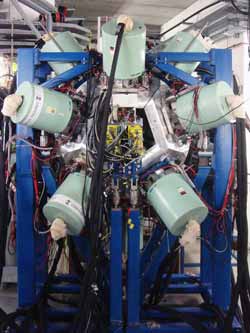Tin-100, a doubly magic nucleus

This is a view of the experiment at the GSI from a perspective against the beam direction. The fragments are stopped at the center of a "hedgehog" of 105 liquid nitrogen-cooled gamma ray detectors, where the precise time point of the beta decay and the released decay energy are measured. Credit: Thomas Faestermann / TUM<br>
Stable tin, as we know it, comprises 112 nuclear particles – 50 protons and 632 neutrons. The neutrons act as a kind of buffer between the electrically repelling protons and prevent normal tin from decaying. According to the shell model of nuclear physics, 50 is a “magic number” that gives rise to special properties. Tin-100, with 50 protons and 50 neutrons, is “doubly magic,” making it particularly interesting for nuclear physicists.
Shooting xenon-124 ions at a sheet of beryllium, the international team headed by physicists from the TU Muenchen, the Cluster of Excellence Origin and Structure of the Universe and the GSI in Darmstadt succeeded in creating tin-100 and analyzing its subsequent decay. Using specially developed particle detectors, they were able to measure the half-life and decay energy of tin-100 and its decay products. Their experiments confirmed that tin-100 has the fastest beta decay of all atomic nuclei, as previously predicted by theoretical physicists.
A repeat of the experiment is slated for the near future at the RIKEN research center in Japan. The beam intensity at RIKEN is higher in the mean time, allowing even more precise measurements. The aim of the research work is to improve the understanding of processes in the formation of heavy elements during explosions on the surface of compact stars. In addition, the researchers hope to draw conclusions on the neutrino mass from the measurements.
This work was supported by the BMBF, by the GSI, by the DFG-Cluster of Excellence Origin and Structure of the Universe, by the EC within the FP6 through I3-EURONS and by the Swedish Research Council.
Original publication:
Superallowed Gamow-Teller Decay of the Doubly Magic Nucleus Sn-100, Hinke et al., Nature, 21. Juni 2012 – DOI: 10.1038/nature11116
The German version is available here: http://www.tum.de/nc/die-tum/aktuelles/pressemitteilungen/kurz/article/2994 7/
Media Contact
More Information:
http://www.tum.deAll latest news from the category: Physics and Astronomy
This area deals with the fundamental laws and building blocks of nature and how they interact, the properties and the behavior of matter, and research into space and time and their structures.
innovations-report provides in-depth reports and articles on subjects such as astrophysics, laser technologies, nuclear, quantum, particle and solid-state physics, nanotechnologies, planetary research and findings (Mars, Venus) and developments related to the Hubble Telescope.
Newest articles

High-energy-density aqueous battery based on halogen multi-electron transfer
Traditional non-aqueous lithium-ion batteries have a high energy density, but their safety is compromised due to the flammable organic electrolytes they utilize. Aqueous batteries use water as the solvent for…

First-ever combined heart pump and pig kidney transplant
…gives new hope to patient with terminal illness. Surgeons at NYU Langone Health performed the first-ever combined mechanical heart pump and gene-edited pig kidney transplant surgery in a 54-year-old woman…

Biophysics: Testing how well biomarkers work
LMU researchers have developed a method to determine how reliably target proteins can be labeled using super-resolution fluorescence microscopy. Modern microscopy techniques make it possible to examine the inner workings…





















